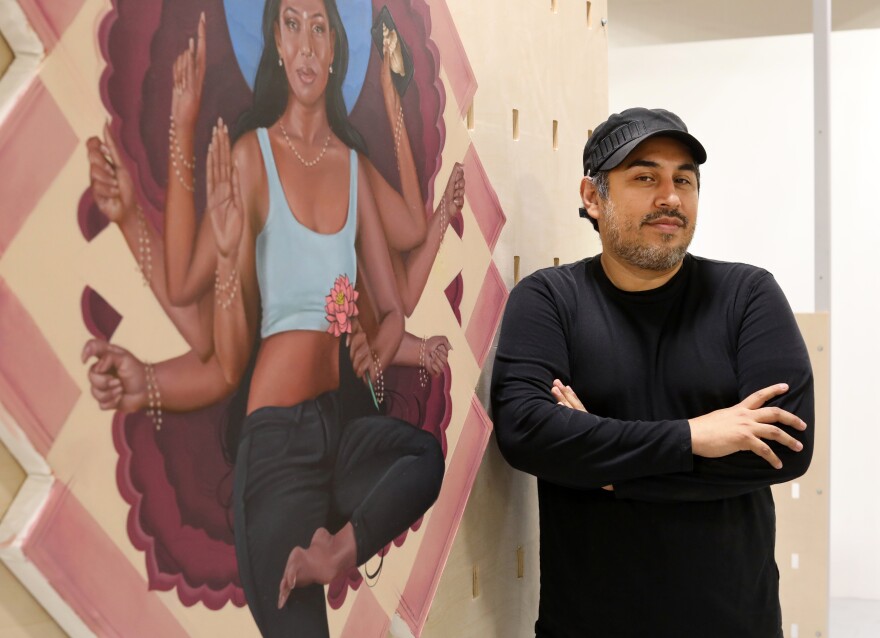Editor's note: This story is part of an ongoing series for Arts Access examining the health and well-being of our North Texas arts economy.
Into the early morning hours, Hatziel Flores would lose track of time painting in his makeshift studio at home.
After countless nights of heading into his job at GameStop completely exhausted, Flores knew something had to change. So, he finally took a leap of faith and decided to become a full-time artist.
But when he told his manager he was quitting his job to become an artist, he was flooded with questions.
“They were like … ‘How are you going to support yourself?’ ” Flores said the first six months after quitting were rough. No galleries would take his work, and he had to sell his car to pay the bills.
That was back in 2007. Now, more than 15 years later, Flores is a professional muralist, painter and graffiti artist. He’s worked with brands like Porsche, sold his work in gallery exhibitions and has colorful murals all across the city, including one in Deep Ellum.
While Flores makes a comfortable living off his artwork now, his journey highlights the industry’s ongoing struggle to pay artists an equitable wage. That conversation has reached a fever pitch recently with writers and actors striking to demand a living wage.
There is a model that determines fair pay for artists. The activist group and nonprofit Working Artists and the Greater Economy (WAGE) sets minimum payment fees for artists to ensure their work doesn’t go uncompensated. Dallas is home to the arts incubator The Cedars Union, one of eight arts institutions in Texas that have been certified through WAGE by agreeing to their fair pay standards.
“The only way that artists can make a living as artists is to make money, and that's really important to us,” said Rachel Stanfield, managing director of The Cedars Union.
The certification means minimum payments for specific kinds of artwork at The Cedars Union are clearly spelled out. For example, artists can expect to always get paid at least $1,250 for a solo exhibition and $500 for a performance of an existing work.
The incubator’s WAGE certification is especially important because it helps protect local emerging artists who are often the most vulnerable in the industry. Without experience or visibility, many of these up-and-coming artists can end up doing artistic work for free to build up their portfolio and reputation.
“[WAGE certification] ensures we never cut corners on what we pay artists for our programs – if we can’t make it work in the budget, we can’t do it, and really that’s how it should be,” Stanfield said.
Flores said joining The Cedars Union’s first cohort back in 2018 accelerated his career by helping him learn the financial side of his business, from copyright issues to marketing. And when Flores does work for The Cedars Union, there’s a baseline of pay he can expect instead of doing work at a discounted rate or for free.
More importantly, Flores said those minimum standards, along with The Cedars’ focus on financial literacy, help local emerging artists understand the value of their work.
“It lets you know what you're worth as an artist,” he said. “That's really important, because a lot of the time we're just guessing, you know?”
Flores said The Cedars Union has taught him how to calculate fair pay for various jobs.
Take, for example, a $2,000 mural job. At first, Flores said that sounds like a good payment. But factoring in materials and equipment the artist might need for the job could bring the take-home pay to $1,000 or less, which doesn’t account for the two weeks of labor or time mapping out the concept.
Before Flores became a cohort member at The Cedars Union, he was charging about $150 per square foot for his paintings. These days, he’s charging at least $300-$400 per square foot.
“It does help you because you grow as an individual, and now you understand your value and then you realize how much you're missing out on as far as money or shows as an artist or the possibilities,” he said.
It’s just one of the many ways Flores has been able to scale up his business as an artist and feel empowered to ask for compensation that matches the quality of his work.
“Artists don't know what to charge and people do take advantage of that as well. Fair pay is very important.”
Arts Access is an arts journalism collaboration powered by The Dallas Morning News and KERA.
This community-funded journalism initiative is funded by the Better Together Fund, Carol & Don Glendenning, City of Dallas OAC, Communities Foundation of Texas, The Dallas Foundation, Eugene McDermott Foundation, James & Gayle Halperin Foundation, Jennifer & Peter Altabef and The Meadows Foundation. The News and KERA retain full editorial control of Arts Access’ journalism.





